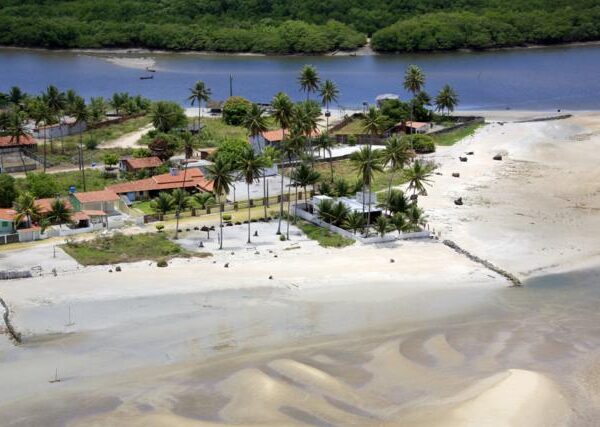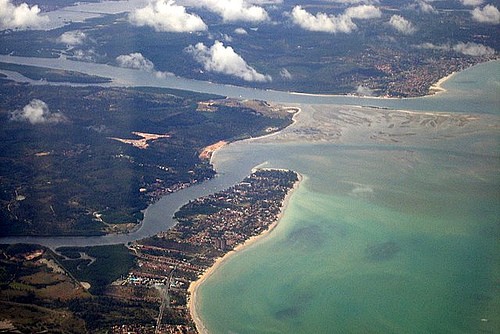Carne de Vaca Beach is a charming destination located in the municipality of Goiana, on the north coast of Pernambuco, near the border with Paraíba. Considered the last beach on the north coast of Pernambuco, Carne de Vaca stands out for its tranquillity and conservation, making it the ideal place […]
North Coast of Pernambuco
The North Coast of Pernambuco: Landscape, History and Culture
The North Coast of Pernambuco is one of the richest regions in the State in terms of historical heritage, cultural diversity and natural attractions.
Its importance goes beyond tourism and includes historical and environmental elements of interest to various fields of knowledge.
1. General Characterisation of the Region
1.1 Location and scope
The region extends from the northern limit of the Recife Metropolitan Region to the border with the State of Paraíba. It includes the municipalities of Olinda, Paulista, Abreu e Lima, Igarassu, Ilha de Itamaracá and Goiana.
1.2 Urbanisation process
The North Coast of Pernambuco has a high degree of urbanisation, especially compared to the South Coast.
This urbanisation is continuous from the capital Recife to the state border, with interconnected urban centres and consolidated infrastructure.
2. Historical and Architectural Heritage
2.1 Historic Municipalities
Municipalities such as Olinda, Goiana and Itamaracá have preserved colonial centres that have been inhabited since the beginning of the 16th century (around 1508), giving the region a high historical value.
2.2 Colonial buildings
Architectural landmarks include
- Fort Orange (Itamaracá Island): Dutch construction from the 17th century.
- Church of Saints Cosme and Damião (Igarassu): believed to be the oldest functioning church in Brazil, dating from 1535.
- Houses and Churches in Goiana: such as the Church of Nossa Senhora do Rosário dos Homens Pretos and the Church of Soledade.
2.3 Museums and Memorials
- Museum of Sacred Art of Goiana
- Santo Antônio Monastery Museum (Igarassu)
- Orange Fort with Museum Exhibition (Itamaracá)
3. Cultural manifestations and popular traditions
3.1 Popular festivals
- Goiana Carnival: Maracatus and Caboclinhos stand out.
- Itamaracá Carnival: blocks of frevo, maracatu and ciranda.
- June Fiestas: with typical food, quadrilhas and forró.
3.2 Ciranda of Lia de Itamaracá
Lia de Itamaracá is a national reference in ciranda, a symbol of local Afro-indigenous culture. Her performances promote the recovery and valorisation of the popular traditions of the Pernambuco coast.
4. Natural attractions and beaches
4.1 Beaches by municipality
- Paulista: Maria Farinha, Pau Amarelo, Janga, Conceição
- Goiana: Pontas de Pedra, Carne de Vaca, Catuama, Barra de Catuama, Atapuz
- Itamaracá: Praia do Forte Orange, Gavoa
- Olinda: Rio Doce and Casa Caiada
- Abreu e Lima: Jaguaribe
4.2 Nature Tourism
- Coroa do Avião Island: Ideal for diving and snorkelling.
- Mangue Seco Beach (Igarassu): Quiet and unspoilt.
- Manguezais Ecological Reserve: with trails and wildlife observation.
5. Tourist and leisure facilities
5.1 Parks and Recreation
- Veneza Water Park (Maria Farinha, Paulista): One of the largest water parks in Brazil, with attractions for all ages.
5.2 Traditional sugar mills
- Engenho Uruaé (Goiana): Preserves the tradition of sugar and cachaça production, with guided tours and cultural activities.
Maria Farinha Beach: Activities and Attractions
Discover the enchanting Maria Farinha Beach in Pernambuco Maria Farinha Beach, located in the municipality of Paulista, Pernambuco, is one of the most enchanting beaches in the Recife metropolitan area. With its clear sand and crystal clear waters, this beach is considered one of the most beautiful on the Pernambuco […]
Itamaracá Island: Your Ultimate Guide to Tropical Bliss in Brazil
Itamaracá Island offers beaches with calm waters and natural pools. Ilha de Itamaracá is a charming tourist destination located off the coast of the state of Pernambuco in Brazil. Known for its natural and historical beauty, the island offers a variety of attractions for all types of visitors. About 50 […]
The north coast of Pernambuco has important historical sites
The North Coast of Pernambuco has one of the most important historical sites of the region. The North Coast of Pernambuco is more densely populated than the South Coast, almost completely urbanised from the Metropolitan Region of Recife to the border with Paraíba. The North Coast of Pernambuco has one […]























